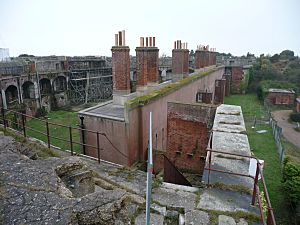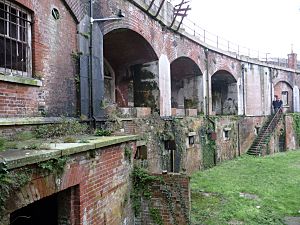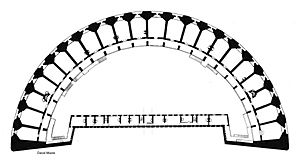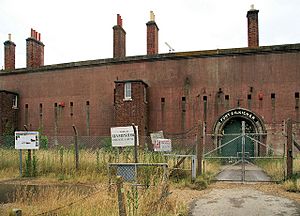Fort Gilkicker facts for kids
Quick facts for kids Fort Gilkicker |
|
|---|---|
| Gosport, England | |
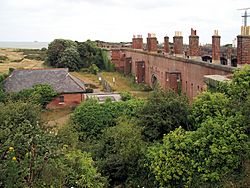 |
|
| Lua error in Module:Location_map at line 420: attempt to index field 'wikibase' (a nil value). | |
| Type | Battery |
| Site information | |
| Condition | Complete, but in disrepair |
| Site history | |
| Built | 1853-1858 (original) 1863-1871 (modern) 1902-1906 (modification) |
| In use | 1858-1956 (as battery) 1956-1999 (as storage) |
Fort Gilkicker is an old fort built a long time ago in Gosport, England. It's a type of fort called a Palmerston fort, named after the Prime Minister who ordered many forts to be built to protect Britain's coast. This fort was built to protect the important area of Spithead, where many ships could anchor safely.
The fort was constructed between 1863 and 1871. It's shaped like a half-circle and has 22 special rooms called casemates for cannons. It was designed to hold many large cannons. Later, around 1902, the older cannons were replaced with newer, more powerful ones. Before World War I, the fort's walls were made even stronger with big piles of earth. Fort Gilkicker stopped being used for defense in 1956 and became a storage place until 1999. Today, it's in bad condition and needs repairs.
Contents
Inside the Fort: How it Worked
The fort has 22 gun casemates, which are like strong, vaulted rooms for cannons. Each casemate has a thick granite front wall, about 14 feet (4.3 meters) thick. Cannons would fire through a protected opening called an embrasure.
Behind each gun casemate was a barrack room where the gun crew could rest. These rooms had space for beds and a fireplace. They opened onto a walkway that connected all the rooms.
Ammunition and Supplies
Below the gun casemates were magazines, which are safe storage areas for shells and cartridges (ammunition). Lifts connected these magazines to each gun casemate, making it easy to bring up ammunition quickly. The magazines were lit by oil lamps on trolleys that ran on rails through special tunnels.
Upper Battery and Barracks
Steps led up from the walkway to an upper area called the upper battery. This area had five large open spaces for even bigger cannons, with smaller magazines nearby for quick access to ammunition.
The back of the fort, called the gorge, was closed off by a two-story barrack block. This building was originally for the officers and included their bedrooms, a dining area (mess), kitchen, and other rooms. There were also artillery stores at each end of the building. The main entrance to the fort was through the middle of this barrack block, leading to a central parade ground. Outside the fort, there was another artillery store and a workshop for repairs.
Fort Gilkicker's Story
Early Fort (1853-1863)
The very first defenses at Gilkicker Point were built around 1853. It was a simple earth wall with openings for eleven cannons. This early fort was criticized because it wasn't very strong and could be easily attacked. Because of these problems, a new, stronger fort was planned to replace it.
Building the Modern Fort (1863-1871)
The Fort Gilkicker we see today was built between 1863 and 1871. Its main job was to defend the deep waters of Spithead and protect the western entrance to Portsmouth harbor.
The construction started with one company, but they ran into trouble. So, a famous engineer named John Towlerton Leather, who was already building other large sea forts nearby, was asked to finish Fort Gilkicker. The new fort was designed to hold 26 cannons on one level, firing through armored openings. It was completed in 1871 with 22 cannons in casemates and five heavier cannons on the roof. The fort cost about £58,766 to build, which was a lot of money back then!
First Version of the Fort (1871-1906)
When it was finished, Fort Gilkicker had 17 large 10-inch cannons and five 9-inch cannons in the lower casemates. On the roof, there were five positions for even bigger cannons, including 11-inch and 12-inch guns. The fort was used for military training and experiments in the 1870s and 1880s. By 1891, some of the cannon positions on the roof were changed into lookout spots, and the cannons were removed.
Second Version of the Fort (1906-1956)
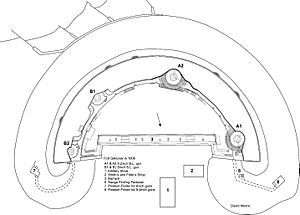
Around 1898, it was suggested that Fort Gilkicker should be updated with the latest cannons. The older cannons in the lower part of the fort were replaced. The upper part of the fort was completely rebuilt to hold two powerful 9.2-inch cannons and two 6-inch cannons. The 9.2-inch cannons were meant to fight large armored ships from far away, while the 6-inch cannons were for closer targets like unarmored ships or those trying to block channels.
This upgrade work started in 1902 and finished in October 1906. It cost about £19,671. The magazines were also changed to hold more ammunition for the new cannons. As part of this work, the entire granite outer wall of the fort was covered with earth. This was done to protect the ammunition stores and make the fort even stronger.
However, by 1905, military leaders decided that the very large cannons at Gilkicker were no longer needed. They believed that any enemy ships would be stopped by other defenses. So, by 1907, the 9.2-inch and 6-inch cannons were removed.
From 1908 to 1910, the barrack block was changed into homes for military engineers. During World War I, in 1916, an early type of anti-aircraft gun was placed on top of the fort to shoot down enemy planes.
During World War II, Fort Gilkicker briefly had a 40mm Bofors gun, which is another type of anti-aircraft gun. Radar equipment was also set up outside the fort to help direct guns at a nearby anti-aircraft site. Leading up to D-Day, a special communications unit used the fort. On D-Day itself, June 9, 1944, they handled over 1,000 messages, routing them to many different places.
Later Uses (1956-1999)
In 1956, the system of coastal defense was changed, and Fort Gilkicker was no longer needed as a battery. It was then used by the government as a workshop. Later, a large wooden signaling station was built on top of the fort. This station was always staffed by former Navy signalmen. They monitored ship movements and helped train Navy personnel in signaling.
From 1959, the fort was used by HMS Dolphin, a nearby naval base, to store spare parts for submarines. The beach next to the fort was closed to the public during this time. In 1986, Hampshire County Council bought the fort. It was used to store building materials from 1987 until 1999.
No Longer Used (1999-Present)
Since 1999, there have been several plans to turn Fort Gilkicker into apartments, but none of them have worked out. In 2012, some work was done to clear overgrown plants, but the main plans didn't happen. In 2016, a new company planned to restore the fort and convert it into modern apartments, and they even started putting up a fence. However, these plans were also stopped in 2018 due to money problems. In November 2019, the fort was put up for sale again.
Fort Gilkicker is a Grade II* Listed Building, which means it's a very important historic building. It's also on the "Buildings at Risk Register" because it's in very poor condition. This is due to a lack of care and many break-ins. In 2016, someone who explores old buildings took pictures inside, showing how much damage there was. Sadly, the fort also had a major fire in March 2019.


